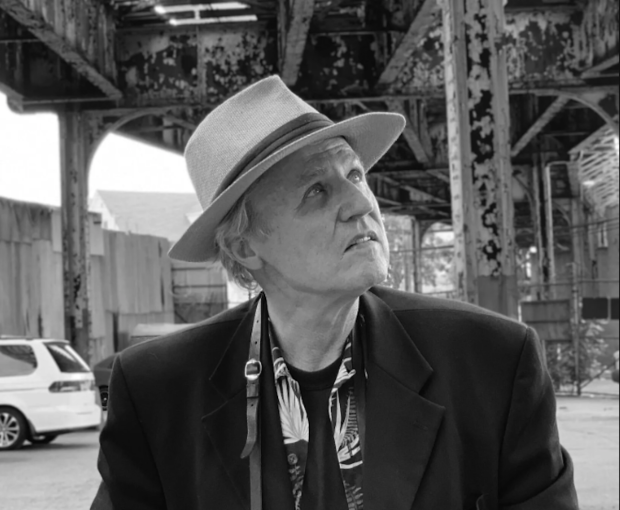Gerard Malanga Brings Film and Poetry to Park Theater in Hudson
The former Warhol Factory star makes a rare appearance on Saturday, November 1.

The former Warhol Factory star makes a rare appearance on Saturday, November 1.

Gerard Malanga has heard his own biography more times than he cares to count. It always begins the same way: Warhol, the Factory, the Velvet Underground. He carries it politely, but not as a burden—more like something he has simply outlived. Ask him what he hopes people understand first about his life’s work and he doesn’t hesitate. “That I’m a poet,” he says. “If that’s the correct answer.”
An Afternoon with Gerard Malanga will be held Saturday, November 1, 2pm at Park Theater in Hudson. The program includes a screening of his 1967 movie In Search of the Miraculous, a poetry reading, Q&A, and book signing.
Malanga lives in Hudson now, where he moved in 2008 after 60 years in Brooklyn. A change of life, he says. Peace and quiet. He bought before the town remade itself into a destination. “I beat the stampede,” he says. After a pause, he continues: “Unfortunately, it’s here now.”
Like what you're reading? Subscribe to our twice-weekly newsletter.
He doesn’t romanticize the Hudson Valley. When asked if the landscape has entered his work, he shrugs. “Not really. There’s more time to write up here. That’s all.” He lives with Rosie now, the young cat he adopted after the death of his previous companion, Odie. “I tell Rosie there are only two people in this house,” he says. “You and me.”
His recent book, Odie Is Being Called Back & Other Poems (Bottle of Smoke Press, 2024), is a small volume with a large center of gravity. Odie came to him at age 20 after a friend could no longer keep him. “He’d been through hell and high water,” Malanga says. “Lost his tail. Born cross-eyed with perfect vision. A sentient being, bar none.” Odie died a year later, but during that time Malanga photographed him constantly and wrote about him without intending to. “The poems poured out of me,” he says. “Maybe 200. The book is a selection.”
The poems are not sentimental. They are precise, steady, unconcerned with performing grief. When asked how he decides what to reveal or withhold in the work, Malanga refuses the premise. “I’m not conscious of that while I’m writing,” he says. “The poems come. That’s it.” He hasn’t written anything new in over a year. He doesn’t force it. “I’m not worried about it,” he says. “I find it mysterious.”
At Park Theater, Malanga will screen In Search of the Miraculous, the movie he made in 1967. The movie, like much of his work, resists summary. It is elliptical, symbolic, a coded autobiography that never asks to be solved. “I made it for myself,” he says simply.

The title comes from a book by P. D. Ouspensky, the Russian philosopher and esotericist. Malanga encountered Ouspensky’s work through the Italian actor Allan Midgette, who appears in the movie (and lived out his final years in Woodstock). “He introduced me to those books,” Malanga says. “He was a dear friend, so I put him in the movie.” Is the movie spiritual? He won’t say. “In a way the movie is about a search,” he allows. “It might come across that way when the audience sees it.”
Along with the screening, he will sign copies of his new book, Gerard Malanga: Secret Cinema, a collection of his writing on movies published by Waverly Press. Malanga has always written about film as seriously as he has made it. In his work, form isn’t a hierarchy but a vocabulary.
His photography is equally central. Though he is known for portraits of Lou Reed, William Burroughs, Patti Smith, Iggy Pop, Anne Waldman, and dozens of other major artists, he does not speak of them as icons. “A lot of the pictures have to do with people I knew,” he says. “They’re always going somewhere or doing something. Looking in a window. Walking.” Only recently, revisiting his archive, has he recognized the pattern. “I didn’t notice it at the time,” he says. “But when you take a body of work like that, patterns emerge.”
He is reorganizing his photographic archive now, one roll of film at a time, pairing contact sheets with 8×10 prints in heavy binders. “I find things I didn’t know were missing,” he says. He works without hurry. The process is slow, but duration has always suited him.

His first photographs were taken when he was 12. He documented the final day of service on the Third Avenue Elevated subway line. Months later, he returned to shoot the dismantled skeleton of the line. “I caught it in a semi-dismantled state,” he says. “Like the Roman ruins.” For Malanga, photography began as a record of disappearance. It may still be.
Malanga was born in the Bronx and went to high school to study commercial art. He expected to work in advertising until a teacher named Daisy Aldan handed him real literature. “Extraordinary teacher,” he says. He began writing poems immediately. In his twenties, he carried a copy of John Ashbery’s The Tennis Court Oath in his coat pocket. “Like a Bible,” he says.
The Factory appears eventually in any conversation about Malanga. He does not avoid it, but he does not expand on it either. “It was part of my life for a while,” he says. That’s all. Then he goes back to talking about what he is making now. He has no interest in being a tour guide to someone else’s mythology.
What remains unfinished? He doesn’t pretend to know. “It’s never-ending,” he says. “I don’t know what remains.” At Park Theater, after the screening and the reading, there will be a Q&A with the audience. He looks forward to it. “I always like the Q&A,” he says. It makes sense. He isn’t a man of declarations. He prefers the open space of questions.